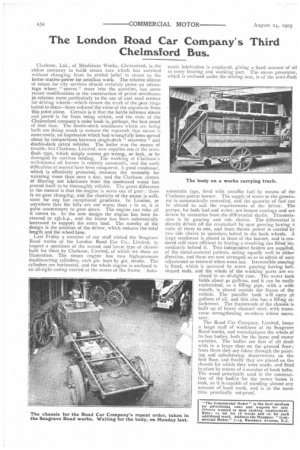The London Road Car Company's Third Chelmsford Bus.
Page 6

If you've noticed an error in this article please click here to report it so we can fix it.
Clarkson, Ltd., of Moulsham Works, Chelmsford, is the oldest company to build steam cars which has survived without changing from its settled belief in steam as the better motive power for omnibus work. The relative silence of steam for city services should certainly prove an advantage where " nerves " enter into the question, but some recent modifications in the construction of petrol omnibuses in relation more particularly to the use of cast steel centres for driving wheels—which ensure the truth of the gear rings bolted to them—have reduced the value of the argument from this point alone, Certain is it that the battle between steam and petrol is far from being settled, and the state of the Chelmsford company's order book is, perhaps, the best proof of that face. The double-deck omnibuses which are being built are doing much to remove the reproach that steam is more costly, an impression which had wrongfully been spread about by comparisons between single-deck " steamers " and double-deck petrol vehicles. The boiler was the source of trouble, but Clarkson, Limited, now supplies one of the semiflash type, which simply cannot go wrong, or leak, or be damaged by careless feeding. The working of Clarkson's well-known oil burner is entirely automatic, and the early difficulties of control have been conquered. A good condenser, which is effectively protected, removes the necessity for watering more than once a day, and the Clarkson system of filtering out lubricants from the condensed water has proved itself to be thoroughly reliable, The great difference in the control is that the engine is never out of gear : there is no gear changing, and the elasticity of the steam is sufficient for any but exceptional gradients. in London, or -anywhere that the hills are not worse than f in lo, it is quite unnecessary to gear down. The engine can take all it comes to. In the new design the engine has been increased to 25b.h.p., and the frame has been substantially increased to support the extra load. The novelty of the design is the position of the driver, which reduces the total length and the wheel base.
Last Friday a member of our staff visited the Seagrave Road works of the London Road Car Co., Limited, to inspect a specimen of the second and latest type of chassis built for them by Clarkson, Limited, of which we show an illustration. The steam engine has two high-pressure double-acting cylinders, each kin. bore by kin. stroke. The cylinders are horizontal, and the whole engine is enclosed in an oil-tight casing carried at the centre of the frame. Auto matic lubrication is employed, giving a fixed amount of oil to every bearing and working part. The steam generator, which is enclosed under the driving seat, is of the semi-flash automatic type, fired with paraffin fuel by means of the Clarkson patent burner. The supply of water to the generator is automatically controlled, and the quantity of fuel can be altered to suit the requirements of the driver. The pumps, for both fuel and water, are bronze castings and are driven by eccentrics from the differential shafts. Transmission is by gearing and side chains. The differential is directly driven off the crankshaft by spur gearing having a ratio of three to one, and from thence power is carried by two side chains to sprockets bolted to the back wheels. A large condenser is placed in front of the bonnet, and is rendered still more efficient by having a revolving fan fitted immediately behind it. Two independent brakes are supplied, of the metal-to-metal pattern, acting equally well in either direction, and these are now arranged so as to admit of easy adjustment or renewal when worn out. Irreversible steering is fitted, which is operated by screw gearing having ballshaped ends, and the whole of the working parts are en
closed in an oil-tight case. The water tank holds about 40 gallons, and it can be easily replenished, as a filling pipe, with a wide mouth, is placed outside the frame of the vehicle. The paraffin tank will carry 36 gallons of oil, and this also has a filling attachment. The framework of the chassis is built up of heavy channel steel, with transverse strengthening members where necessary.
The Road Car Company, Limited, keeps a large staff of workmen at its Seagrave Road works, and manufactures the whole of its bus bodies, both for the horse and motor varieties. The bodies are first of all dealt with in a large shop on the ground floor; from there they are taken through the painting and upholstering departments on the first floor, and finally they are placed on the chassis for which they were made, and fiexd in place by means of a number of hook bolts. The wood principally used in the construction of the bodies for the motor buses is teak, as it is capable of standing almost any amount of hard work, and is at the same time practically rot-proof.
















